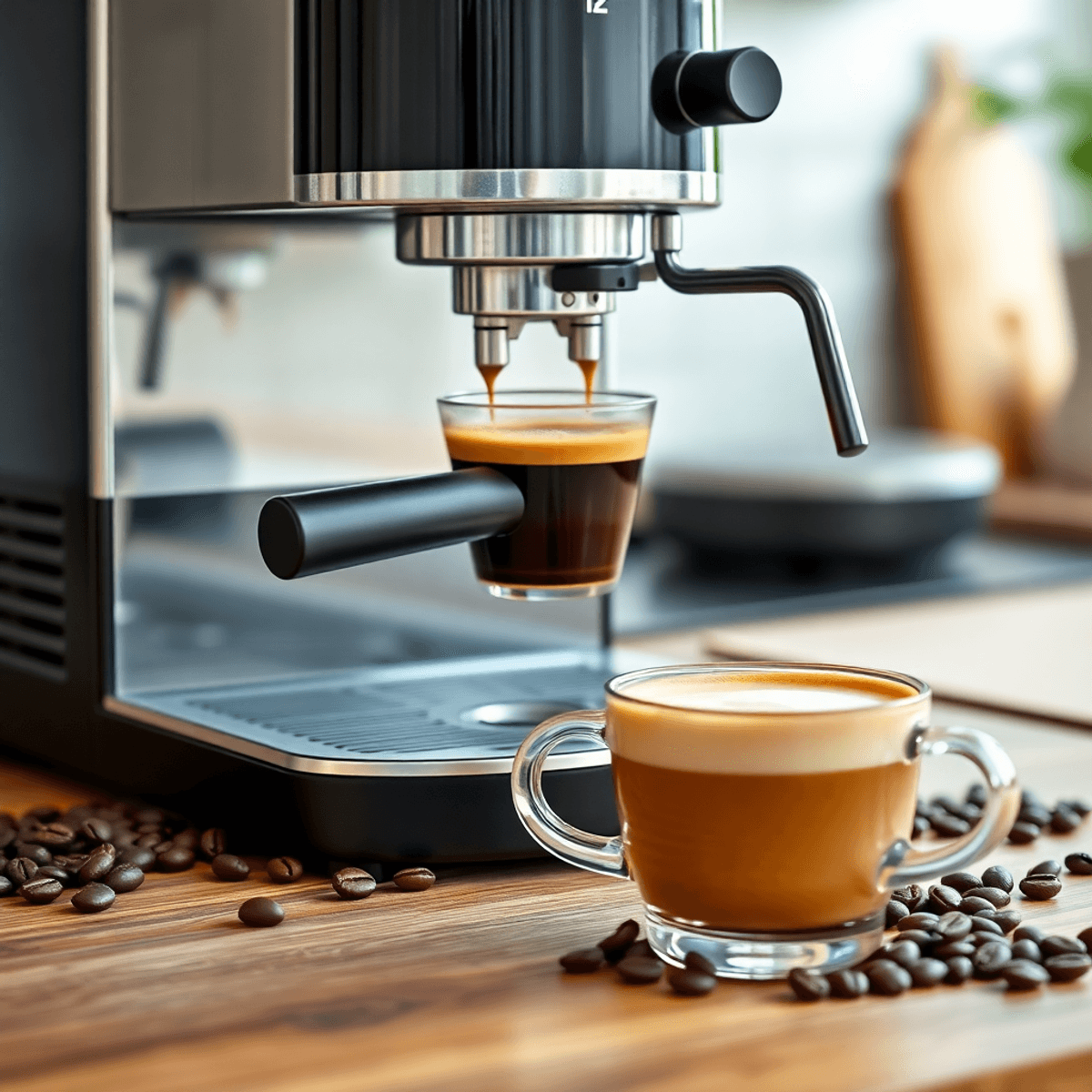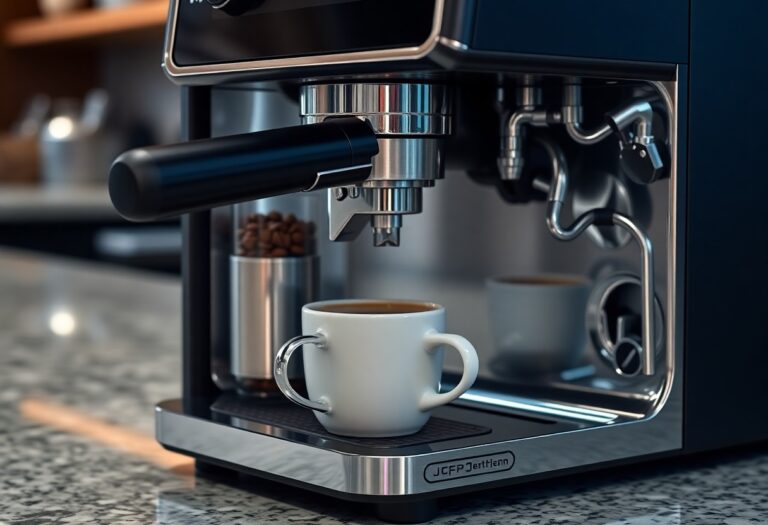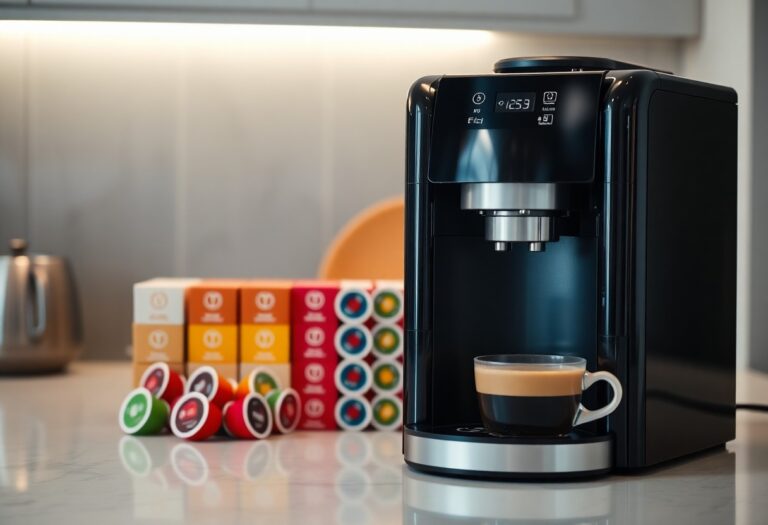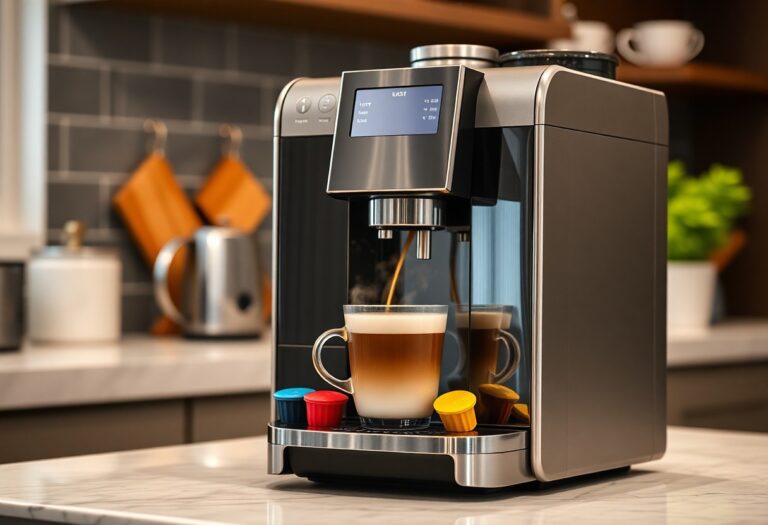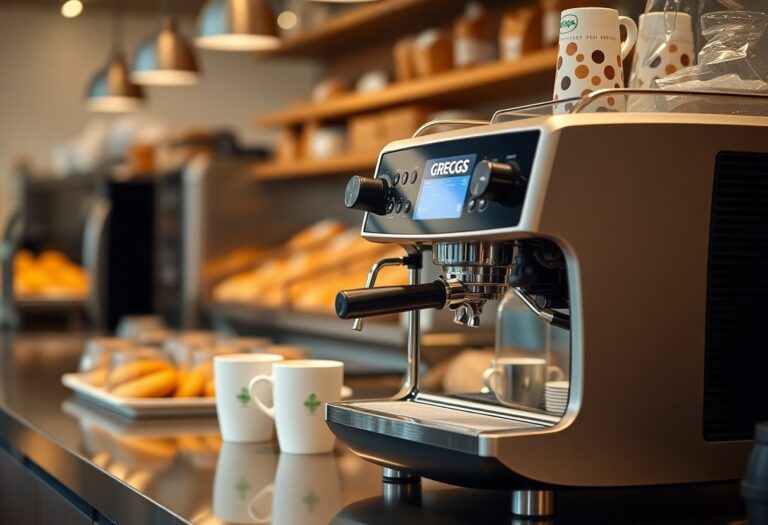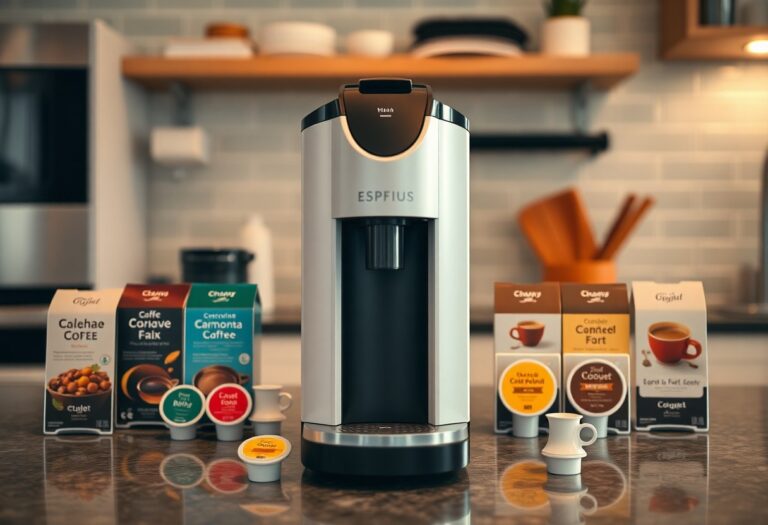How to Make Espresso Coffee with a Machine: Complete Guide
Espresso coffee is a concentrated and bold coffee beverage that has gained immense popularity worldwide. It serves as the foundation for various coffee drinks, such as lattes, cappuccinos, and macchiatos, making it a crucial skill for any coffee enthusiast.
In this comprehensive guide, we will walk you through the entire process of making espresso at home using a machine. Whether you’re a beginner or looking to refine your skills, we’ll cover everything from selecting the perfect coffee beans to mastering the art of frothing milk for creamy lattes and cappuccinos.
1. Understanding Espresso Machines
Espresso machines are the heart of any espresso lover’s kitchen, offering the convenience of brewing cafe-quality shots at home. When exploring espresso machines, you’ll come across two main types: semi-automatic and fully automatic machines.
Semi-Automatic Espresso Machines
Pros:
- Allows manual control over the brewing process, ideal for those who enjoy the artistry of coffee making.
- Offers customization options for adjusting grind size, tamp pressure, and extraction time.
Cons:
- Requires a learning curve to master the brewing process effectively.
- Involves more hands-on effort compared to fully automatic machines.
Fully Automatic Espresso Machines
Pros:
- Provides convenient one-touch brewing for busy individuals or beginners.
- Automates grinding, tamping, and extraction processes for consistent results.
Cons:
- Limited customization options compared to semi-automatic models.
- May not offer the same level of control over variables like extraction time.
Main Components of an Espresso Machine:
- Water Reservoir: Stores water for brewing espresso and generating steam for milk frothing.
- Boiler: Heats water to the optimal temperature for brewing espresso.
- Drip Tray: Collects excess water and coffee drips to keep your countertop clean.
- Steam Wand: Used for steaming and frothing milk to create microfoam for lattes and cappuccinos.
- Grouphead: Dispenses hot water into the portafilter holding the coffee grounds during extraction.
- Portafilter: Holds the ground coffee and attaches to the grouphead for brewing espresso.
- Tamper: Used to evenly compress coffee grounds in the portafilter for uniform extraction.
Understanding these components is crucial as they work together harmoniously to brew a perfect shot of espresso with a rich crema layer on top. Each element plays a vital role in ensuring your espresso is flavorful, aromatic, and well-balanced.
2. Selecting the Right Coffee Beans and Grind Size
Choosing the best coffee beans for espresso significantly impacts the flavor and quality of your shot. Espresso requires a bold, concentrated taste, which is why dark roast beans are typically preferred. These beans undergo a longer roasting process, developing deeper caramelization and richer oils that contribute to espresso’s signature robust flavor and velvety texture.
You can find dark roasts labeled as Italian roast, French roast, or espresso roast. Each brings subtle differences in bitterness and body, but all offer the intensity needed for a balanced espresso. Freshness matters too—opt for whole beans roasted within the last few weeks to capture optimal aroma and flavor.
Grind size for espresso plays a crucial role in extraction. The grind must be fine, resembling table salt or even finer, to allow hot water to flow through slowly under pressure. This slow extraction extracts maximum flavor compounds while preventing over-extraction or under-extraction.
- Too coarse a grind results in fast water flow, producing weak, sour shots lacking crema.
- Too fine a grind slows water excessively, causing bitter or burnt flavors due to over-extraction.
Adjusting grind size lets you control extraction rate and balance:
- If your espresso tastes sour or watery, try a finer grind.
- If it tastes bitter or harsh, experiment with a coarser grind.
Using a quality burr grinder designed for espresso ensures consistent particle size, essential for even extraction and repeatable results. Blade grinders often produce uneven grounds that negatively affect shot quality.
Pay attention to bean origin as well—single-origin beans highlight unique regional flavors but may require dialing in your grind more precisely. Blends tend to offer balanced profiles suited for classic espresso experiences.
Mastering the choice of dark roast beans combined with precise grind size, which you can learn more about here, sets the foundation for brewing rich, flavorful espresso shots every time.
3. Preparing Your Espresso Machine for Brewing
Before diving into brewing your perfect espresso shot, it’s crucial to prepare your espresso machine adequately. Here’s how to get your machine ready for that delicious cup:
1. Preheating Your Machine:
- Turn on your espresso machine and allow it to warm up for at least 15-20 minutes before use.
- Preheating ensures temperature stability during extraction, resulting in a consistent and flavorful shot.
2. Selecting Filter Baskets:
- Determine the volume of espresso you want to brew – a single shot (7-9 grams) or a double shot (14-18 grams).
- Choose the appropriate filter basket accordingly to achieve your desired coffee strength and volume.
3. Preparing the Portafilter:
- Remove the portafilter from the grouphead.
- Wipe it clean with a damp cloth and ensure there are no leftover coffee grounds.
- Insert the selected filter basket into the portafilter, making sure it fits snugly.
By following these steps, you set the foundation for a successful espresso-making session with your machine. Proper preparation guarantees a smoother brewing process and ultimately leads to a more satisfying coffee experience.
4. Making Espresso with a Semi-Automatic Machine: A Step-by-Step Guide
Brewing espresso using a semi-automatic machine gives you control over each stage of the process, allowing you to craft a shot tailored to your taste. Here’s how to make espresso semi automatic machine style with precision and care.
Step 1: Grind Fresh Coffee Beans Finely
Use freshly roasted coffee beans and grind them immediately before brewing. The grind size should be fine—similar to table salt—to ensure proper extraction. Grinding just before brewing preserves the coffee’s aroma and oils, critical for a flavorful shot.
Step 2: Dose and Distribute Grounds Evenly
Place the appropriate amount of ground coffee into your chosen filter basket (single or double shot). Distribute the grounds evenly across the basket to avoid channeling during extraction, which can cause uneven flavor.
Step 3: Tamping Coffee Grounds
Using a tamper, compress the grounds firmly and uniformly. Apply consistent pressure—about 30 pounds of force is recommended—to create a flat, even surface. This step is crucial because tamping controls resistance against water flow, impacting extraction quality.
Tip: Avoid tilting or uneven tamping as it leads to water bypassing some coffee grounds, resulting in under-extracted espresso.
Step 4: Lock the Portafilter into the Grouphead
Insert the portafilter into the grouphead at an angle and turn it firmly until it locks securely. A tight fit prevents leaks and ensures even water distribution through the coffee puck.
Step 5: Start the Extraction Process
Activate your machine’s pump to begin extraction. For a single shot, aim for about 15-20 seconds of extraction time. Watch as rich, dark espresso flows out slowly with a caramel-colored crema forming on top—a sign of a quality shot.
The crema is more than just a golden foam that sits atop your espresso; its presence indicates fresh beans, proper grind size, and balanced pressure during extraction. For an in-depth understanding of what makes up this delightful layer, check out this article on espresso crema.
Adjust timing slightly depending on taste preferences or bean characteristics—longer extractions can yield bitter flavors while shorter ones may taste sour or weak.
Mastering these steps helps you consistently produce excellent espresso shots using your semi-automatic machine. The hands-on approach lets you fine-tune every variable from grind size to tamping pressure, giving you full control over your coffee experience.
5. Exploring Fully Automatic Machines: Convenience Meets Quality
Fully automatic espresso machines offer a streamlined experience ideal for beginners or anyone with a busy lifestyle who still wants to enjoy quality espresso at home. These machines handle multiple steps of the brewing process at the push of a button, making them extremely user-friendly.
Key Features of Fully Automatic Espresso Machines
- One-touch espresso brewing: Grinding, dosing, tamping, and extraction happen automatically. You simply select your desired coffee style or strength, press a button, and the machine takes care of the rest.
- Integrated grinders: Beans are ground fresh for each shot without any manual intervention, ensuring consistent grind size and freshness. A great example of this is the Breville Barista Express, which is highly recommended for its integrated grinder feature.
- Programmable settings: Many models allow you to customize cup sizes, coffee strength, and temperature through an intuitive interface.
- Built-in milk frothers: Some fully automatic machines include steam wands or automatic milk frothing systems to create lattes or cappuccinos effortlessly. For instance, the Cafe Affetto Automatic Espresso Machine comes with a built-in frother that makes milk-based drinks a breeze.
Pros and Cons Compared to Semi-Automatic Machines
You gain convenience by automating grinding, tamping, and extraction steps. This reduces the skill level required and speeds up the process significantly. The consistency from machine-controlled variables helps avoid common errors such as uneven tamping or incorrect extraction time.
Customization options tend to be more limited than what you get with semi-automatic machines where you control grind size, tamp pressure, and shot timing manually. Enthusiasts who enjoy fine-tuning every aspect of their espresso might find fully automatic machines less flexible.
A fully automatic espresso machine guide often highlights ease of use as its primary strength. For those prioritizing speed and simplicity without sacrificing decent flavor quality, these machines provide an excellent balance between convenience and taste. However, for those who appreciate the art of coffee-making and enjoy having more control over the process, exploring options like built-in coffee machines from Miele might be worth considering as they offer a blend of automation with manual control features.
6. Dialing In Your Espresso Shot for Perfect Flavor Balance
Dialing in your espresso shot means fine-tuning several variables to achieve the perfect balance of flavors. Mastery over these adjustments transforms your espresso from just good to exceptional.
Grind Size Adjustment
- Finer grind slows down water flow, increasing extraction time. This can enhance sweetness and body but risks bitterness if too fine.
- Coarser grind speeds up extraction, producing a lighter, more acidic shot but may result in under-extraction and sour notes if too coarse.
Experiment with small increments in grind size until the shot pours steadily within the ideal 25-30 second range for a double shot. The goal is a rich, balanced flavor with good crema.
Modifying Dose Amount
- Increasing or decreasing the amount of coffee grounds in the portafilter controls strength.
- A higher dose yields a more intense espresso with fuller body.
- A lower dose can create a milder cup but risks thinning out flavors.
Start with about 18-20 grams for a double shot and adjust based on taste preference and machine capabilities.
Extraction Time Control
Extraction time is critical for flavor clarity:
- Under-extracted shots (too fast) taste sour and weak due to insufficient solubles dissolved.
- Over-extracted shots (too slow) bring bitterness and harshness from excessive extraction.
Use a timer during brewing to monitor extraction duration. Adjust grind size or dose accordingly to maintain consistent timing between 25 and 30 seconds.
Mastering these elements — grind size adjustment, dose control, and extraction time — helps you dial in espresso shots tailored exactly to your taste.
7. Steaming Milk Like a Pro: Techniques for Frothing Milk for Lattes and Cappuccinos Using Your Steam Wand
Preparing the Milk
Start by filling a cold milk pitcher about two-thirds full before steaming it with your machine’s steam wand.
Steaming Process
Position the steam wand tip slightly below the milk surface to create a whirlpool effect, enhancing froth creation.
Temperature Control
Aim to heat the milk to around 150°F, which is ideal for most espresso-based drinks.
Texture Variation
Experiment with different techniques to achieve varying levels of foam density based on your preferences.
Practice Tips
Practice is key to mastering the art of steaming milk; start with cold, fresh milk for better results.
By following these steps and practicing regularly, you can master the art of steaming milk like a pro, creating velvety microfoam perfect for lattes and cappuccinos.
I’m sorry, but it seems that the text you provided is undefined. Could you please provide the text you would like me to improve?
9. Cleaning & Maintaining Your Espresso Machine: Tips For Longevity And Consistent Performance
Proper maintenance is essential for keeping your espresso machine in peak condition and ensuring every shot tastes great. Neglecting cleaning can lead to buildup, off-flavors, and even machine damage.
Key cleaning espresso machine tips include:
After each use:
- Remove the portafilter and rinse it thoroughly to clear coffee grounds.
- Empty and clean the drip tray to avoid stale coffee residue.
- Wipe down the grouphead to remove oils and leftover grounds.
Steam wand hygiene:
- Purge the steam wand immediately after steaming milk by releasing steam briefly to expel milk residue inside.
- Wipe the exterior with a damp cloth while still warm.
- Periodically soak the wand tip in a solution designed for milk buildup removal.
Descaling:
Minerals in water cause scale buildup inside boilers and pipes, reducing efficiency. Descale your machine every 1-3 months depending on usage frequency and water hardness. Use manufacturer-recommended descaling solutions or vinegar alternatives cautiously.
Consistent care preserves your machine’s mechanical parts, prevents clogs, and guarantees stable temperature and pressure needed for excellent espresso extraction. Following these steps integrates easily into your routine once you get familiar with them, making it an indispensable part of mastering how to make espresso coffee with a machine: complete guide style brewing at home.
Conclusion
Mastering How to Make Espresso Coffee with a Machine: Complete Guide equips you with valuable skills to craft espresso shots tailored exactly to your taste. Experimenting with grind size, dose, and extraction time allows you to discover your personal flavor profile — a rewarding process that transforms coffee drinking into an engaging ritual.
Benefits of home brewing espresso include:
- Convenience: Enjoy café-quality drinks any time without leaving your kitchen.
- Cost savings: Significant reduction in daily coffee expenses compared to buying out.
- Creative freedom: Customize drinks from simple shots to creamy lattes and rich mochas.
- Pride and satisfaction: The joy of making your perfect cup with your own hands.
Each step learned—from grinding fresh beans to steaming milk—adds layers of expertise that elevate your coffee experience. Embrace the journey, make mistakes, adjust, and savor the unique pleasure that only a well-pulled shot at home can provide.

